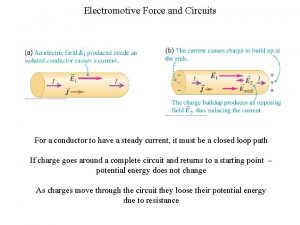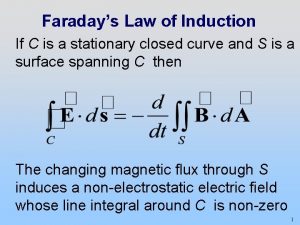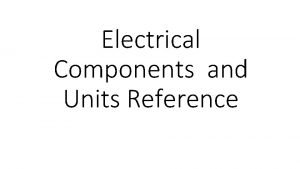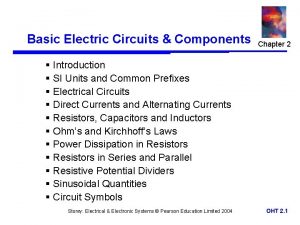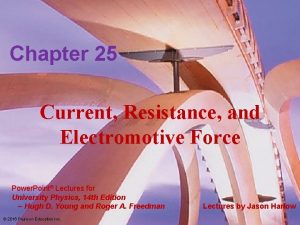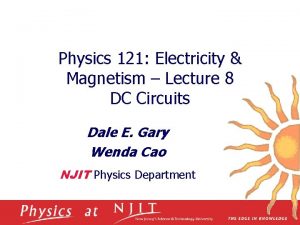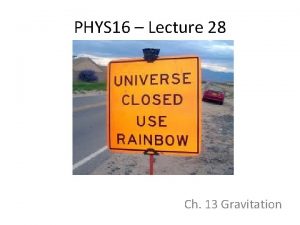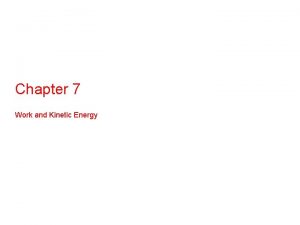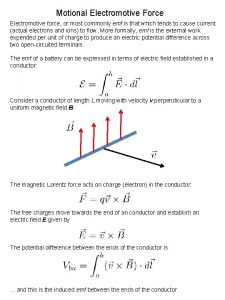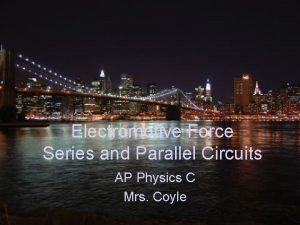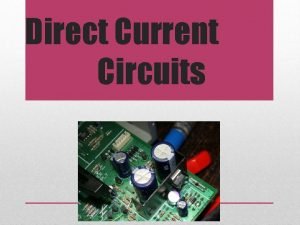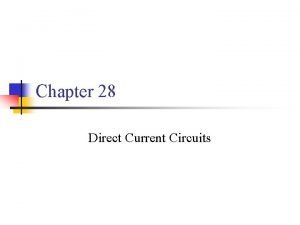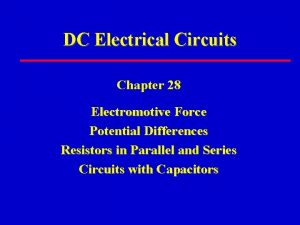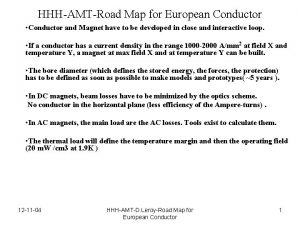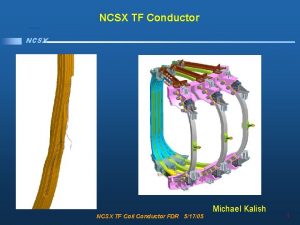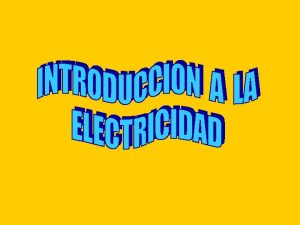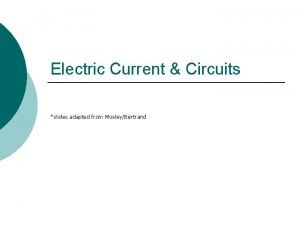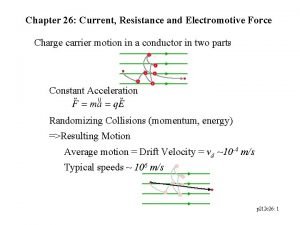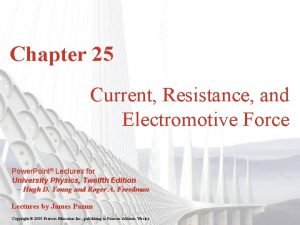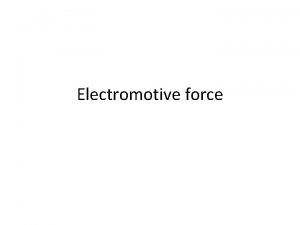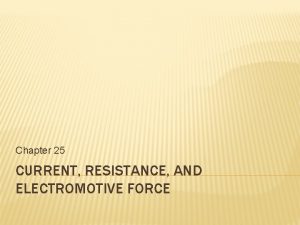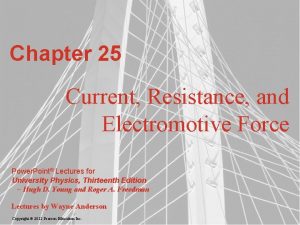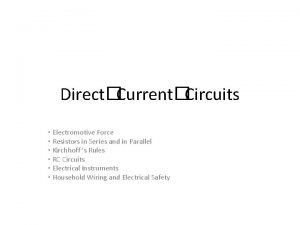Electromotive Force and Circuits For a conductor to




















- Slides: 20

Electromotive Force and Circuits For a conductor to have a steady current, it must be a closed loop path If charge goes around a complete circuit and returns to a starting point – potential energy does not change As charges move through the circuit they loose their potential energy due to resistance

“Electromotive force” (emf, ε) is produced by a battery or a generator and acts as a “charge pump”. It moves charges uphill and is equal to the potential difference across such a device under open-circuit conditions (no current). In reality, batteries have some internal resistance. Emf is measured in Volts (so it is not a “force” per say, but potential difference) Sources of emf – batteries, electric generators, solar cells, fuel cells

Internal Resistance In ideal situation, As the charge flows through the circuit, the potential rise as it passes through the ideal source is equal to potential drop via the resistance, Evolution of the electric potential in the circuit with a load

We measure currents We measure voltages with voltmeters with ammeters An ideal voltmeter would have an infinite resistance An ideal ammeter would have a zero resistance Example: What are voltmeter and ammeter readings?

Examples Bulb B is taken away, will the bulb A glow differently? Which bulb glows brighter?

Potential changes around the circuit Potential gain in the battery Potential drop at all resistances In an old, “used-up” battery emf is nearly the same, but internal resistance increases enormously

Electrical energy and power Chemical energy → Electric potential energy → Kinetic energy of charge carriers → Dissipation/Joule heat (heating the resistor through collisions with its atoms) As the charge goes through the resistance the potential energy q. V is expended (if both q and V are positive), but charge does not acquire kinetic energy (current is constant). Instead, it converted to heat. The opposite can also happen – if change in potential energy is positive, the charge acquires it - battery

Power Output of a Source

Power Input to a Source Current flows “backwards” Rate of conversion of electric energy into non-electrical energy Work is being done on, rather than by the top battery (source of non-electrostatic force)

Circuits in Series • Resistance (light bulbs) on same path • Current has one pathway - same in every part of the circuit • Total resistance is sum of individual resistances along path • Current in circuit equal to voltage supplied divided by total resistance • Sum of voltages across each lamp equal to total voltage • One bulb burns out - circuit broken - other lamps will not light (think of string of old Christmas lights)

Water Analogy for Series Circuits ISNS 3371 - Phenomena of Nature

Resistors in series

Parallel Circuits • Bulbs connected to same two points of electrical circuit • Voltage same across each bulb • Total current divides among the parallel branches - equals sum of current in each branch - current in each branch inversely proportional to resistance of branch • Overall resistance of circuit lowered with each additional branch • Household wiring (and new Christmas light strings) designed in parallel - too many electrical devices on - too much current - trip fuse/breaker

Water Analogy for Parallel Circuits ISNS 3371 - Phenomena of Nature

Resistors in parallel

Calculating resistance A variable cross-section resistor treated as a serial combination of small straight-wire resistors:

Example: Equivalent resistances

Series versus parallel connection What about power delivered to each bulb? What if one bulb burns out?

Symmetry considerations to calculate equivalent resistances No current through the resistor I 2 I 1 I 1 I 2

Kirchhoff’s rules To analyze more complex (steady-state) circuits: 1. For any junction: Sum of incoming currents equals to sum of outgoing currents (conservation of charge) Valid for any junction 2. For any closed circuit loop: Sum of the voltages across all elements of the loop is zero (conservation of energy) Valid for any close loop - The number of independent equations will be equal to the number of unknown currents Loop rule – statement that the electrostatic force is conservative.
 Electromotive force and circuits
Electromotive force and circuits Young and freedman
Young and freedman Electromotive force unit
Electromotive force unit Si unit of charge
Si unit of charge Kirchhoff
Kirchhoff Gaya elektromotif
Gaya elektromotif Sources of electromotive force
Sources of electromotive force Electromotive force ppt
Electromotive force ppt What is electromotive force
What is electromotive force The mass of rectangular sheet of wood varies jointly as
The mass of rectangular sheet of wood varies jointly as Advantages of parallel circuits over series circuits
Advantages of parallel circuits over series circuits Centripetal force and gravitational force
Centripetal force and gravitational force Hooke's law vector form
Hooke's law vector form Internal force
Internal force Fspos
Fspos Novell typiska drag
Novell typiska drag Nationell inriktning för artificiell intelligens
Nationell inriktning för artificiell intelligens Returpilarna
Returpilarna Varför kallas perioden 1918-1939 för mellankrigstiden
Varför kallas perioden 1918-1939 för mellankrigstiden En lathund för arbete med kontinuitetshantering
En lathund för arbete med kontinuitetshantering Underlag för särskild löneskatt på pensionskostnader
Underlag för särskild löneskatt på pensionskostnader
